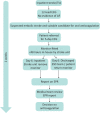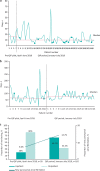Quality Improvement in Atrial Fibrillation detection after ischaemic stroke (QUIT-AF)
- PMID: 32934041
- PMCID: PMC7539720
- DOI: 10.7861/clinmed.2020-0322
Quality Improvement in Atrial Fibrillation detection after ischaemic stroke (QUIT-AF)
Abstract
Background: Paroxysmal atrial fibrillation (PAF) is a frequent cause of recurrent stroke but can be difficult to detect because of its episodic and often asymptomatic nature. We sought to improve rate of PAF detection through a quality improvement project (QIP) to deliver early prolonged inpatient cardiac monitoring on the stroke unit (SU).
Methods: A structured protocol for cardiac monitoring using 5-day event recorders was established. 'In-house' cardiac monitoring was implemented. Performance data on this change in service was analysed prospectively and summary statistics obtained.
Results: One-hundred and two ischaemic stroke (IS) patients undertook 5-day event recorder monitoring. Provision of monitors as an inpatient (IP) increased from 20% (pre-QIP pilot 2018) to 65.7% (during QIP). New AF was detected in 15 patients (14.7% vs 8.6% pre-QIP pilot 2018) with majority of new AF (13 patients; 19%) detected when monitors applied early (IP) after IS.
Conclusion: Although this study had a number of limitations, it did demonstrate that early and prolonged non-invasive IP cardiac monitoring could be delivered 'in-house' on the SU and improve AF detection rates.
Keywords: Ischaemic stroke; anticoagulation; cardiac monitoring; paroxysmal atrial fibrillation.
© Royal College of Physicians 2020. All rights reserved.
Figures



Similar articles
-
Improving detection and management of atrial fibrillation after ischaemic stroke in Glasgow (IMPROVE-AF): A quality improvement project.J R Coll Physicians Edinb. 2022 Sep;52(3):213-219. doi: 10.1177/14782715221120133. Epub 2022 Aug 22. J R Coll Physicians Edinb. 2022. PMID: 36369810
-
Atrial fibrillation and paroxysmal atrial fibrillation detection in patients with acute ischemic stroke.J Stroke Cerebrovasc Dis. 2014 May-Jun;23(5):1138-41. doi: 10.1016/j.jstrokecerebrovasdis.2013.09.032. Epub 2013 Nov 1. J Stroke Cerebrovasc Dis. 2014. PMID: 24189453
-
Excessive supraventricular activity and risk of atrial fibrillation in patients with cryptogenic ischaemic stroke.Neurol Neurochir Pol. 2022;56(1):75-80. doi: 10.5603/PJNNS.a2022.0009. Epub 2022 Jan 20. Neurol Neurochir Pol. 2022. PMID: 35050495
-
Paroxysmal atrial fibrillation after ischemic stroke: how should we hunt for it?Expert Rev Cardiovasc Ther. 2013 Apr;11(4):485-94. doi: 10.1586/erc.13.21. Expert Rev Cardiovasc Ther. 2013. PMID: 23570361 Review.
-
Use of Prolonged Cardiac Rhythm Monitoring to Identify Atrial Fibrillation After Cryptogenic Stroke.Curr Cardiol Rep. 2022 Apr;24(4):337-346. doi: 10.1007/s11886-022-01652-1. Epub 2022 Feb 16. Curr Cardiol Rep. 2022. PMID: 35171442 Review.
Cited by
-
Clinical and health economic evaluation of a post-stroke arrhythmia monitoring service.Br J Cardiol. 2022 May 31;29(2):15. doi: 10.5837/bjc.2022.015. eCollection 2022. Br J Cardiol. 2022. PMID: 36212791 Free PMC article.
References
-
- Murtagh B, Smalling RW. Cardioembolic stroke. Curr Atheroscler Rep 2006;8:310–6. - PubMed
-
- Stroke Association State of the Nation: Stroke Statistics. Stroke Association, 2016. www.stroke.org.uk/sites/default/files/stroke_statistics_2015.pdf [Accessed 29 September 2019].
-
- Lip GYH. Paroxysmal atrial fibrillation. QJM 2001;94:665–78. - PubMed
-
- Kolominsky-Rabas PL, Weber M, Gefeller O, et al. Epidemiology of ischemic stroke subtypes according to TOAST criteria: incidence, recurrence, and long-term survival in ischemic stroke subtypes: a population-based study. Stroke 2001;32:2735–40. - PubMed
-
- Royal College of Physicians. National clinical guideline for stroke. London: RCP, 2016. www.rcplondon.ac.uk/guidelines-policy/stroke-guidelines [Accessed 29 September 2019].
MeSH terms
LinkOut - more resources
Full Text Sources
Medical

